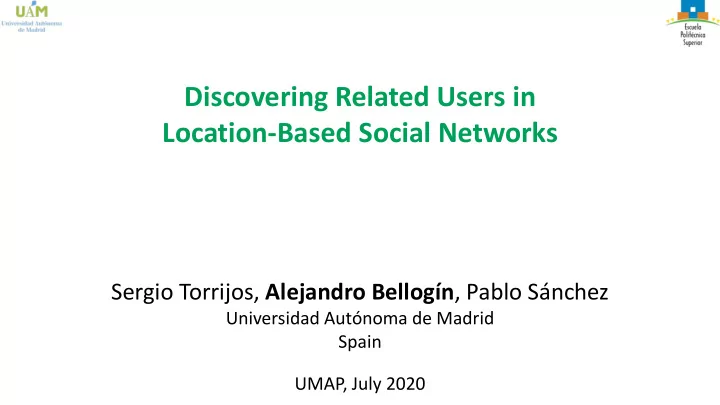

Discovering Related Users in Location-Based Social Networks Sergio Torrijos, Alejandro Bellogín , Pablo Sánchez Universidad Autónoma de Madrid Spain UMAP, July 2020
Motivation ▪ Neighbour-based recommender systems • Easy to understand and implement • Allow straightforward explanations ▪ In this work: focus on LBSN (users check-in in POIs) • Is it possible to adapt similarity metrics to this domain? • In particular: how can we integrate sequentiality and geographical information into neighbour-based recommendation? 2 Alejandro Bellogín – UMAP, July 2020
Context ▪ Recommender systems • Users interact (rate, purchase, click) with items 3 Alejandro Bellogín – UMAP, July 2020
Context ▪ Recommender systems • Users interact (rate, purchase, click) with items 4 Alejandro Bellogín – UMAP, July 2020
Context ▪ Recommender systems • Users interact (rate, purchase, click) with items 5 Alejandro Bellogín – UMAP, July 2020
Context ▪ Recommender systems • Users interact (rate, purchase, click) with items • Which items will the user like ? 6 Alejandro Bellogín – UMAP, July 2020
Context ▪ Nearest-neighbour recommendation methods • The item prediction is based on “similar” users 7 Alejandro Bellogín – UMAP, July 2020
Context ▪ Nearest-neighbour recommendation methods • The item prediction is based on “similar” users 8 Alejandro Bellogín – UMAP, July 2020
Different similarity metrics – different neighbours 9 Alejandro Bellogín – UMAP, July 2020
Different similarity metrics – different neighbours 10 Alejandro Bellogín – UMAP, July 2020
Different similarity metrics – different neighbours s( , ) sim( , )s( , ) 11 Alejandro Bellogín – UMAP, July 2020
Research question ▪ Based on typical interactions in Location-Based Social Networks… G E J D I A B K H L C F can we identify different types of users and select the most relevant ones as neighbours? 12 Alejandro Bellogín – UMAP, July 2020
Discovering related users Sunday Monday A G J D E B G A J E H C D J I H ▪ Classical user similarities: related if G E users share items in common J D ▪ Our approach: relatedness depends I A on when and how near items are B K H 13 L Alejandro Bellogín – UMAP, July 2020 C
Discovering related users Sunday Monday A G J D E B G A J E H C D J I H ▪ Classical user similarities: related if → Captures global preferences users share items in common ▪ Our approach: relatedness depends → Useful for contextual on when and how near items are suggestions 14 Alejandro Bellogín – UMAP, July 2020
Exploiting temporal and geographical information ▪ Exploiting check-ins within a temporal window: ad-hoc Euclidean • focus on check-ins around the same time J’s Window D’s Window DTW A J D ▪ Exploiting common trajectories G • Users are similar if their trajectories J E are similar • Trajectory similarity metrics: C D – Dynamic Time Warping (DTW) 15 – Hausdorff distance Alejandro Bellogín – UMAP, July 2020
Experiments ▪ Foursquare data: Tokyo from global check-in dataset (33M) ~ 328K ▪ Temporal Split: 6 months for training, 1 month test ▪ Baselines • UB: neighbour recommender with classic user similarity • IB: neighbour recommender with classic item similarity • BPR: Bayesian Personalised Ranking using a matrix factorisation algorithm • IRenMF: matrix factorisation algorithm that exploits geographical influence ▪ Metrics • NDCG: accuracy of item recommendations • FA: feature agreement, or precision in terms of category matching (not items) • AD and EPC: diversity and novelty metrics 16 Alejandro Bellogín – UMAP, July 2020
Performance comparison ▪ Neighbours are not competitive against MF methods in terms of accuracy 17 Alejandro Bellogín – UMAP, July 2020
Performance comparison ▪ Neighbours are not competitive against MF methods in terms of accuracy ▪ Much better results are found for beyond-accuracy dimensions: • Ad-hoc is the best one for diversity (AD) • Similarity with Hausdorff is the best one for category accuracy (FA) 18 Alejandro Bellogín – UMAP, July 2020
Impact on local vs tourist users ▪ There are different types of users in LBSNs: • Locals (if their check-ins span more than 21 days) vs tourists ▪ IRenMF is still the best approach ▪ But neighbour recommenders improve their performance for tourists • In particular, for FA Local users Tourist users 19 Alejandro Bellogín – UMAP, July 2020
Social network analysis ▪ How similar are the found neighbours to explicit social connections? ▪ TS-Haus always obtains more social connections than the baseline UB ▪ Performance accuracy on tourist users is competitive (T-NDCG) ▪ Feature agreement is always better than baseline (T-FA) 20 Alejandro Bellogín – UMAP, July 2020
Conclusions ▪ Two novel similarity metrics for LBSN are proposed • Integrating the temporal dimension and geographical information ▪ Competitive results in terms of beyond-accuracy metrics • Novelty and diversity • Especially positive when users are identified as tourists ▪ Future: explore research on mining GPS trajectories to analyse its application to check-ins from LBSNs 21 Alejandro Bellogín – UMAP, July 2020
Thank you Discovering Related Users in Location-Based Social Networks Slides, code and more: http://ir.ii.uam.es/~alejandro/publications.html Sergio Torrijos, Alejandro Bellogín, Pablo Sánchez Universidad Autónoma de Madrid Spain UMAP, July 2020 22 Alejandro Bellogín – UMAP, July 2020
Recommend
More recommend